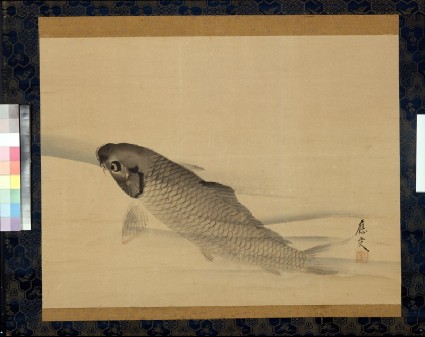Browse: 1524 objects
- Reference URL
Actions
Carp swimming in clear water
-
Details
- Associated place
-
Asia › Japan › Honshū › Kyōto prefecture › Kyoto (possible place of creation)
- Date
- 1777 - 1815
- Artist/maker
-
Kinoshita Ōju (1777 - 1815) (artist)Maruyama-Shijō School (active late 18th century - late 19th century)
- Material and technique
- ink and light colour on paper
- Dimensions
- 43.1 x 57.5 cm (height x width)
- Material index
- Technique index
- Object type index
- No. of items
- 1
- Credit line
- Purchased with the assistance of the Friends of the Ashmolean, and Mr and Mrs J. Hillier, 1973.
- Accession no.
- EA1973.144
-
Further reading
Katz, Janice, Japanese Paintings in the Ashmolean Museum, Oxford, with an introductory essay by Oliver Impey (Oxford: Ashmolean Museum, 2003), no. 20 on p. 88, illus. p. 89
Location
-
- currently in research collection
Objects are sometimes moved to a different location. Our object location data is usually updated on a monthly basis. Contact the Jameel Study Centre if you are planning to visit the museum to see a particular object on display, or would like to arrange an appointment to see an object in our reserve collections.
Publications online
-

Japanese Paintings in the Ashmolean Museum
Ōju was Maruyama Ōkyo’s second son. He was never to head the Maruyama school himself, that role fell to his elder brother Ōshin, so he took the name of Kinoshita and began a branch family.
Ōju's father painted several images of carp, the best known perhaps being a pair of hanging scrolls in Daijōji temple, Hyōgo of 1789 showing a carp ascending a waterfall and one swimming in calmer waters [this is published in Hyōgo Prefectural Museum of History, Maruyama Ōkyo ten: botsugo nihyakunen kinen (Hyōgo: Hyōgo Prefectural Museum of History, 1994), 115]. Several of Ōkyo’s drawings of carp remained for his students to use when composing their own paintings. Like his other illustrations of fish. Ōkyo no doubt based these drawings on studies from life. In this image, Ōju has painted a single carp which swims just below the surface in the transparent water. With an economy of brushwork, Ōju succeeds in conveying the palpable volume of the fish in his own essay of one of his school’s specialities. Notably, in contrast to many paintings of carp by other artists of the Maruyama school active at this time, Ōju has chosen not to fully describe the fish in crisp detail, but instead has painted a more spontaneous and playful image.
© 2013 University of Oxford - Ashmolean Museum

